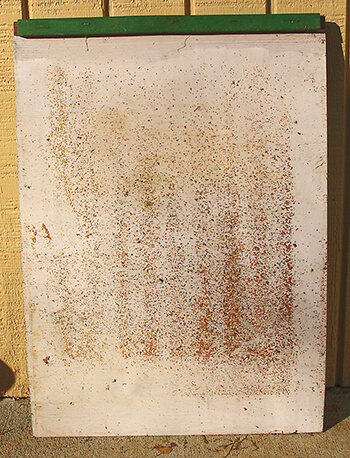
Does a screened bottom board have any value? My vote is a resounding “Yes!” even though they are basically useless as a way to control varroa mites. A screened bottom board, especially when used with a sliding varroa drawer beneath it, can be a valuable diagnostic tool for the beekeeper. And for the beginner, it can provide a fascinating look at life inside the hive.
We usually associate the development of screened bottom boards with varroa mites, but according to Wyatt Mangum,1 the screened bottom board with a removable drawer was first used in 1853 for the control of wax moths. Wax moth larvae fell to the floor of the hive, through the screen, and landed on the drawer. Happy with plentiful wax debris to examine, the larvae stayed there until they were removed by the beekeeper.
This method of wax moth control eventually fell out of favor and beekeepers returned to solid bottom boards until varroa mites came along. Suddenly, screened bottom boards with removable drawers became must-have bee equipment.
The current thinking is that although some mites lose their grip and fall through the screen, the number of mites lost this way isn’t enough to make a difference. Mite counts based on the number of individuals that fall through the hive during a measured interval also have been questioned. The number of mites on a board is highly variable based on the time of year and the size of the colony, making it impossible to devise reliable rules for treatment based on mite drop alone.
Differing Opinions
As a result of disappointing mite control, many beekeepers are abandoning their screened bottoms and returning to solid bottom boards. But those who stick with them recognize their utility as a diagnostic tool. And because they are so valuable, beekeepers have found ways to alter screened bottom boards to minimize their shortcomings.
Some beekeepers find screened bottom boards useful for the control of small hive beetles in much the same way they were once used for wax moths.2 The larvae fall through the screen and land on the board. For beetles, the board can be replaced with an oil tray to drown the larvae.
Paradoxically, another benefit of screened bottom boards, ventilation, is also seen as one of their shortcomings. Some beekeepers, especially in colder climates, believe the screens allow too much heat to escape through the bottom of the hive, even with a varroa drawer in place. Other cold climate beekeepers—those who enjoy the advantages of the varroa drawers—fit a piece of foam board or other rigid insulation between the screen and the drawer during the winter months.
Unfortunately, sometimes beekeepers find clusters of bees hanging from the underside of a screened bottom board. This is most apt to happen in warm weather and appears to be a form of bearding. Usually, the bees go back inside when daily temperatures begin to drop. Although I have never seen it, some beekeepers report newly constructed honeycombs in this inconvenient location.
How the Drawer is Useful
A sliding varroa drawer can reveal secrets from within the hive. It is similar to an observation window or to a sampling port, like those on a wine cask. It provides a non-invasive way to learn what is going on inside your hive. Together with other observations, such as entrance activity or heat measurements, you can piece together a picture of colony activity.
Of course, the stuff that lands on screened bottom boards is the same stuff that lands on solid bottom boards. But the difference is your ability to see it easily and to evaluate the pattern of accumulation. For example, in mid-winter you can scrape the accumulation from a solid bottom board through the hive entrance, but the pile you get is not very instructive. But pull out a varroa drawer and you can easily see the size and location of your cluster.
In warmer months, the screen separates the bees from their debris. Honey bees are tireless housekeepers, and what they don’t manage to carry out, drops to the bottom. During summer, your bees are wizards at keeping the bottom board clean, and so they often remove evidence before you see it. But with a screened bottom, the bees are prevented from reaching the pieces that fall through. They have no choice but to leave them there for you.
Harmless Accumulations
Regardless of the type of bottom board you have, many different things will collect there. Most items are benign. Like trash from your house, it is the detritus of creatures living in a confined space. The accumulation is also ….


